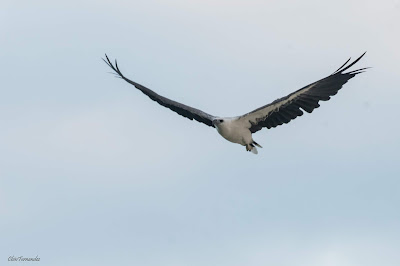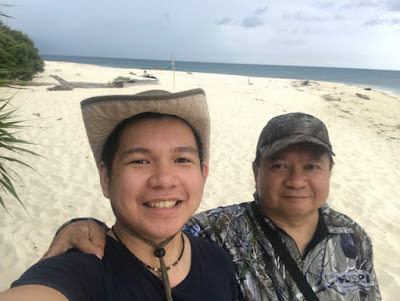Even before I became a birder, Ursula Island was already on my bucket list of places to visit. So when I became one in 2012, Ursula moved up near the top of the list. That it took several attempts and six years before it came true only underscores how difficult it is to visit this island.
Ursula Island is located in Southern Palawan, approximately 24.2 kms East South East from the Rio Tuba wharf. Rio Tuba is a mining community in southern Palawan, and a part of the municipality of Bataraza. It is the southernmost municipality of mainland Palawan and its town center is 272.5 kms from Puerto Princessa City. Rio Tuba is another 25 kms from the Poblacion.
Ursula Island as shown in Google Maps
On this trip, Luis, my elder son was going with me. Our journey began at dawn of April 7 for we had to be at the airport by 4am for our 6am flight to Puerto Princessa city. We landed at PPC airport a little after 7am and was met by Rommel Cruz of Wild Expeditions Palawan, the tour organizer. After picking up supplies and provisions at the WEP office, and picking up the rest of the expedition members, we were off. Our party consisted of ten (10) guests, plus Rommel and the driver. Another van contained another group of Palaweno campers and outdoor enthusiasts.
For geography nuts like me, here is a map of Palawan.
For geography nuts like me, here is a map of Palawan.
Two hours later, after passing through southern Puerto Princessa and the town of Aborlan, we made a stopover at the town of Narra where the expedition team bought fresh food ingredients to be cooked in the island. It was also an opportunity for brunch, where else, but in Jollibee!
Langhap Sarap!
Luis, brought some school work along. Doing a paper while we were at Jolibee Narra.
Having a title as "The Rice Granary of Palawan" Municipality of Narra is the main rice producer of the Province of Palawan. (source: wikipedia)
After about thirty minutes in Narra, we set off again and after another two hours, we made a brief stop at Brooke's Point, arguably, the most progressive town of Southern Palawan and the most likely capital of the soon to be Palawan del Sur province. Along the way we passed through the town of Sofronio Espanola.
It is named after Sir James Brooke.
This is where the original home of the biggest pearl in the world, known as the Pearl of Lao Tzu or the Pearl of Allah, found in its waters on May 7, 1934. (source: wikipedia)
Some sights in Brooke's Point:

A practical way to keep the bathroom clean...
After stretching our limbs and a quick trip to the bathroom, and a cigarette for some, we were off again. Next stop Bataraza.
The municipality was named after Datu Bataraza Narrazid, a locally influential Muslim chieftain and father of the town's first mayor and former mayor of Brooke's Point, then Datu Sapiodin Narrazid. Bataraza was part of the municipality of Brooke's Point until 1964 by the virtue of Philippine RA 3425.[4]
Main industries of Bataraza includes farming, fishing, and nickel mining and processing. (source: wikipedia).
We reached Bataraza after another hour and a half on the road. We were met by their Municipal Tourism Officer who gave us the permits for Ursula Island, (the island is a Protected Sanctuary and one needs a special permit to go there). Then we proceeded with the last leg of our journey, to Bgy Rio Tuba, a mining community. We checked in to a small lodging house with the longest key chain I have ever seen:
And it seems, they celebrate Christmas the whole year... (the rooms had names, ours was Danny).
After putting down our stuff, Luis promptly lied down and went to sleep. I did some exploring and ended up in a small eatery where I ordered Halo-halo.
The following morning, we checked out after breakfast and proceeded to the wharf. It turned out that our boat was the PNP Maritime speedboat, complete with uniformed and armed (with automatic rifles!).
The seas were a bit rough and pretty soon we were all wet (except for those who stayed inside the cabin. However, because we were on a speedboat, the normal two-hour trip took only one hour. And as soon as we set foot on the island, we were greeted by a friendly White-bellied Sea Eagle.
White-bellied Sea Eagle
After getting our fill with the Eagle, we set off into the forest for our first attempt to see our target birds - the Nicobar Pigeon and Grey Imperial Pigeon. Both would be lifers for me. I noticed that there were plenty of big and tall trees, including several Balete trees.
Several minutes into our hike, the skies darkened and it drizzled a bit. Two of our companions decided to go back to the camp. We continued on but I already wrapped both my camera and backpack in their respective rain covers. But the rain did not continue. Both Rommel and the local guide said they could hear (or maybe sense), the Nicobars but I couldn't see (or hear) anything. And I was busy trying not to step or brush into some thorny bushes (there were a lot). I cannot recall anymore how many minutes we walked but Rommel pointed to a distant tree and it was there, my main target bird, the Nicobar Pigeon... a lifer... but it was quite far and difficult to handheld get a shot through a gap in the leaves (especially when one is breathing heavily from traipsing through the forest. Actually, I am just out of shape. As my wife and doctor often reminds me. hehehe). Fortunately, I had a tripod along so I was able to manage a docu shot.
My first view of a Nicobar Pigeon in the wild.
It was already around midday so we made our way back to the beach and to our camp for lunch. Along the way, we saw a lone Grey-tailed Tattler on on of the rocks. And the White-bellied Sea Eagle kept flying about.
After a sumptuous lunch, most of our companions, including Luis, took a nap but I decided to take more photos of the Eagle.
I also took the opportunity to take some photos of the strong waves that kept pounding the western side of the island the whole day.
At around three o-clock, we set out again to look for the Nicobars. Rommel went with the other birders, while I was paired with the local park ranger, whose name escapes me now. It did take very long and I had my second view of the Nicobar, still from high up, but a bit more open.
A slightly better shot of the Nicobar Pigeon.
Another shot of this very elusive and skittish bird.
As we were walking, we came upon a very tall tree, perhaps twenty meters high (maybe more) and saw four Nicobar Pigeons perched but no clear shots. Then a Grey Imperial Pigeon, perched in one of the branches almost directly overhead. But it did not stay long. I did manage one docu shot.
Grey Imperial Pigeon, another lifer
Soon, it was time to go back to camp and wait for the Pied Imperial Pigeons. Ursula is a roosting site for these birds. Every morning, at sunrise, they fly to the mainland to look for food. At sunset, they all fly back to the island. Rommel instructed us to set up and wait on the beach facing west (the mainland). While waiting, the White-bellied Sea Eagle kept putting on a show.
After about twenty minutes, the first wave of birds started to arrive. What followed was a spectacle that I am glad I got to experience with one of my children. Wave upon wave of birds, hundreds, maybe even more than a thousand in all, flying towards Ursula Island.
Pied Imperial Pigeons
I have seen some photos and heard stories, but nothing really prepares you for the experience. Perhaps, I was too excited, or perhaps my camera settings were not correct, or perhaps, I should have had my camera and lens cleaned before going to Ursula. Whatever it is, I feel that my photos do not do justice to the actual experience. I hope I get a chance to photograph these birds again...
The following morning, before we left the island, Luis and I took the obligatory selfie. It was a special weekend for me made more meaningful with the presence of Luis.
With my son Luis
Our last look of Ursula Island
Hope to see you again Ursula! There is some special feeling knowing that you are on a remote island at the edge of one's country... Lawak Island on the Spratly's chain would be nice too...







































No comments:
Post a Comment